Physical Address
304 North Cardinal St.
Dorchester Center, MA 02124
Physical Address
304 North Cardinal St.
Dorchester Center, MA 02124

Pacifiers are a common sight in nurseries around the world. They can be a lifesaver for soothing fussy babies and helping them sleep. But how many pacifiers does a baby actually need? This article will explore this question and offer tips for choosing and using pacifiers safely and effectively.
Pacifiers can offer several benefits for both babies and parents:
Sucking on a pacifier can mimic breastfeeding or bottle-feeding, helping to calm and comfort a fussy baby.
Sucking can be a natural pain reliever for teething babies.
Pacifiers may help babies fall asleep and stay asleep longer.
Studies suggest a link between pacifier use and a reduced risk of Sudden Infant Death Syndrome (SIDS).
It’s important to note that the American Academy of Pediatrics (AAP) recommends offering a pacifier at naptime and bedtime to reduce the risk of SIDS.
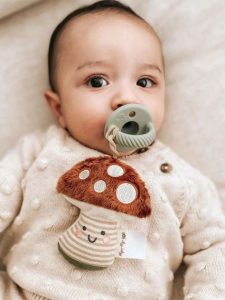
There’s no magic number when it comes to pacifiers. The number you need will depend on several factors:
Baby’s Preference: Some babies love pacifiers and use them frequently, while others have little interest.
Age and Development: Newborns may not need as many pacifiers as older babies who are more mobile and tend to drop them more often.
Lifestyle: If you travel often or have multiple caregivers, having a few extra pacifiers on hand can be helpful.
A good starting point is to have 2-4 pacifiers. This allows you to have one in use, a spare, and potentially one for the diaper bag.
With so many pacifier options available, choosing the right one can be overwhelming. Here are some factors to consider:
Material: Silicone and latex are the most common materials. Silicone is typically more durable, while latex may be more comfortable for some babies.
Shape: Pacifiers come in various shapes, like round, orthodontic, and cherry-shaped. Experiment to see which one your baby prefers.
Size: Choose a pacifier size appropriate for your baby’s age. A pacifier that’s too large can be a choking hazard.
Safety Features: Look for pacifiers with a safety handle that makes it easy for your baby to hold and for you to remove.
Remember, consult your pediatrician for guidance on choosing a pacifier for your baby.
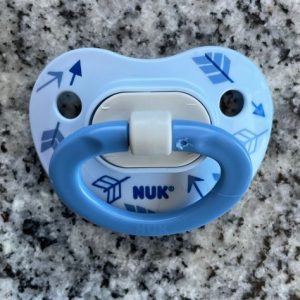
Here are some tips for safe and effective pacifier use:
Clean Regularly: Wash pacifiers with warm soapy water before each use.
Inspect Regularly: Throw away any pacifiers that are cracked, torn, or sticky.
Avoid Attaching to Strings or Clips: These can be a strangulation hazard.
Don’t Force It: If your baby rejects a pacifier, don’t force it. Try again later.
Wean When Appropriate: The AAP recommends weaning babies off pacifiers by around 1 year old.
By following these tips, you can ensure your baby uses pacifiers safely and effectively.
Pacifiers can be a valuable tool for soothing and comforting babies. There’s no one-size-fits-all answer to how many pacifiers you need. The key is to find what works for you and your baby. Always prioritize safety and follow your pediatrician’s guidance.
With a little planning and these helpful tips, you can make pacifiers a positive part of your baby’s soothing routine.
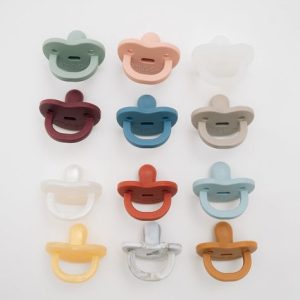
With so many pacifier options available, choosing the right one can be overwhelming. Here are some factors to consider:
Material: Silicone and latex are the most common materials. Silicone is typically more durable, while latex may be more comfortable for some babies.
Shape: Pacifiers come in various shapes, like round, orthodontic, and cherry-shaped. Experiment to see which one your baby prefers.
Size: Choose a pacifier size appropriate for your baby’s age. A pacifier that’s too large can be a choking hazard.
Safety Features: Look for pacifiers with a safety handle that makes it easy for your baby to hold and for you to remove.
Remember, consult your pediatrician for guidance on choosing a pacifier for your baby.
By following these tips, you can ensure your baby uses pacifiers safely and effectively.
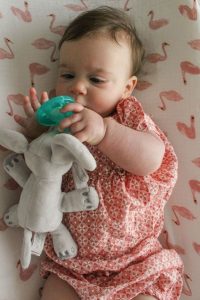
There’s no magic number when it comes to pacifiers. The number you need will depend on several factors:
Baby’s Preference: Some babies love pacifiers and use them frequently, while others have little interest. Observe your baby’s cues.
Age and Development: Newborns may not need as many pacifiers as older babies who are more mobile and tend to drop them more often.
Lifestyle: If you travel often or have multiple caregivers, having a few extra pacifiers on hand can be helpful.
A good starting point is to have 2-4 pacifiers. This allows you to have one in use, a spare, and potentially one for the diaper bag.
Here are some additional tips:
Remember, pacifiers can be a helpful tool for soothing some babies. But it’s always best to follow your pediatrician’s guidance on using pacifiers safely and effectively. They can advise you on the best practices for your baby’s specific needs.
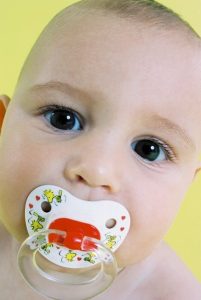
To make the most of your baby’s pacifiers, consider the following tips: